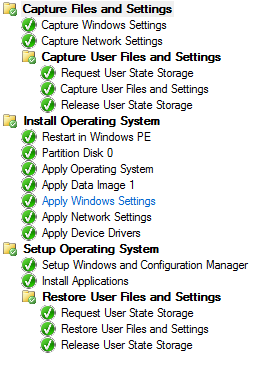Using USMT Windows XP to Windows 7 on the same PC, best practice
Hi There,
Just wondering if somebody can give me some advise. I want to use usmt 4 in sccm 2012 to deploy Windows 7, replacing are current Windows XP enviroment. I want to set it up so the user state is backed up and restored on the same PC after osd. I don't really know were to start.
Can anybody tell me whats the best method for this, I would very much like to re-format the drive during the osd. Id there any way to partition the disk to make a small partition for local usmt as from reading if you use locally stored USMT you can't re-partition / format.
I am also open to the idea of State Migration Point on SCCM 2012 but at a glance it requires two different physical PC's to create a relationship.
In a nutshell, I'd just like a bit of advise if anybody has done this. I have 600 PC's to get through.
Cheers
N
Answers (4)
Hi N,
You can build a task sequence that you deploy to the computer that uses SMP. Essentially the user data goes to the SMP. then the task sequence will wipe the drive. then install os apps and restore data. here is a pic on what the basic task sequence looks like. of course you will need to include drivers etc.

Comments:
-
Hi there thanks for that suggestion. The problem that I see here is, I have to create an association in the 'user state migration' section of sccm 2012 for SMP to work, " correct me if i'm wrong" and the only migration strategy it seems to allow is side by side. eg. If you create a computer association it asks for a source and destination PC. I've tried entering same workstation name for both and it doesn't like it. If an in-place association could be created your suggestion would definitely be my preferred method. I have a hardlink task sequence that scanstates locally, wipe and loadstate but to be honest i've had some issues with failing task sequences. I could really do without having to salvage USMToffline data from PC's with failed TS's as I have 600 to do. I just dont fully trust local migration.
I've never used sccm 2007 but I have seen State Migration screen dumps from the console and it seems to allow both migration types.
If you had any insight into this it would be much appreciated. - sonik777 10 years ago
I am runnning with batch files from kace, you should be able to adopt that concept to SCCM.
Use can use pstools - psexec to run the batch remotely also.
We do a WOL on the machine at 2am and then a script runs at 2:30 to capture the user states.
net use v: \\dr-main\images /user:tmccadmn\user password
v:
cd usmt
md %COMPUTERNAME%
v:\usmt\x86\scanstate v:\usmt\%COMPUTERNAME% /i:v:\usmt\x86\migapp.xml /i:v:\usmt\x86\miguser.xml /l:v:\usmt\%COMPUTERNAME%\mig.log /o /v:5 /uel:120 /ui:tmccadmn\*
we then image the machine and apply the same name and run this batch to put the user states back.
net use v: \\dr-main\images /user:tmccadmn\user password
v:\usmt\x86\loadstate v:\usmt\%COMPUTERNAME%\migstore /i:v:\usmt\x86\migapp.xml /i:v:\usmt\x86\miguser.xml /l:v:\usmt\%COMPUTERNAME%\migstore\mig.log /v:5 /uel:120 /ui:tmccadmn\*
I am using a customized Out-Of-the-Box MDT Task Sequence. I have specified that I want USMT to use Hardlink (just a parameter in the USMT Capture Task).
The PC is not formatted, but the TS automatically takes care of doing a complete disk cleanup preserving only the local USMT data. It works fine.
If you really want to reformat the disk and at the same time use local USMT, then things get more complicated. But why do you want to do so?




